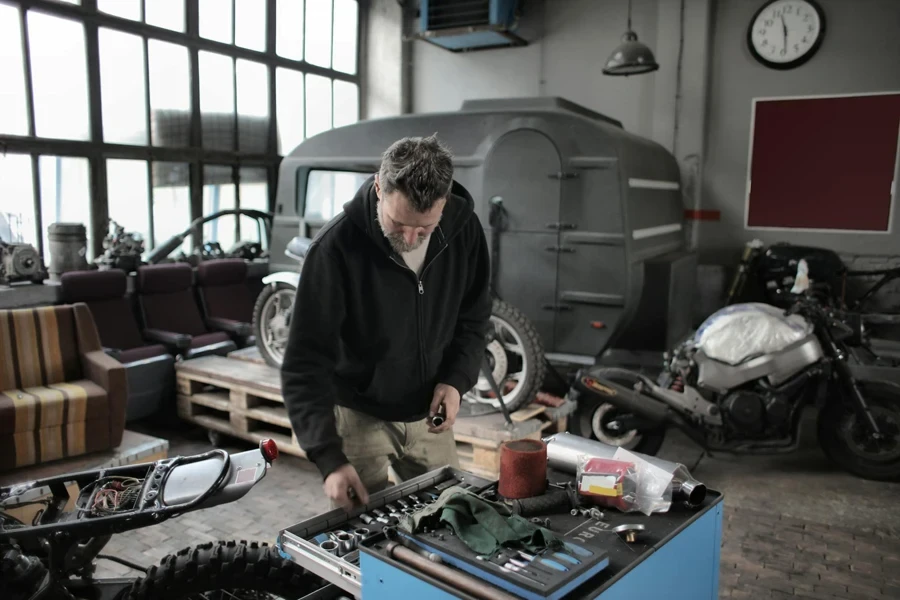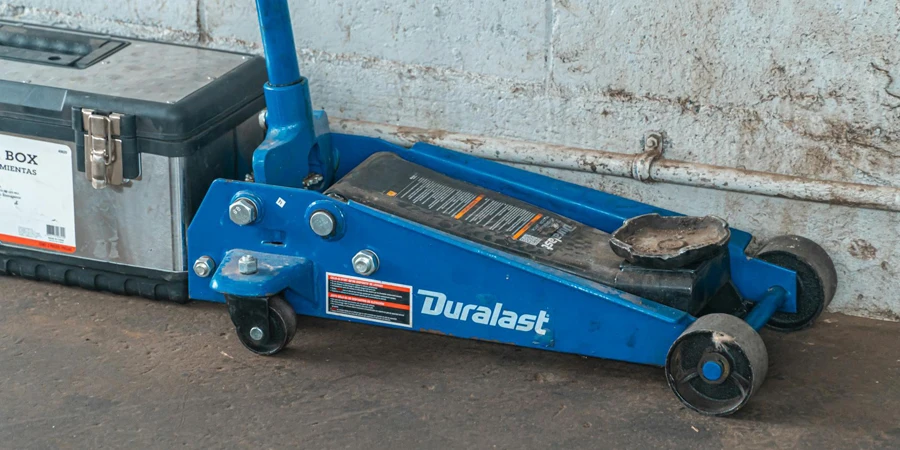Table of Contents
● Introduction
● Market overview
● Different types and their features
● Things to consider when selecting car jacks
● Conclusion
Introduction
Choosing the right car jack is essential for effective vehicle maintenance and repair. Various types of car jacks, such as scissor, bottle, floor, pneumatic, and farm jacks, are examined in-depth. Key considerations like weight capacity, clearance, portability, construction, and safety features are highlighted to aid in making an informed decision. The market overview provides insights into trends and technological advancements in car jack design. Understanding these factors ensures both safety and efficiency in vehicle-related tasks.
Market overview
The car jack market is currently valued at approximately USD 1.1 billion and is projected to reach USD 1.8 billion by 2030, with a compound annual growth rate (CAGR) of 8.77%, according to Verified Market Reports. This growth is driven by increasing vehicle ownership and the rising demand for regular vehicle maintenance and repair services. As more consumers prioritize vehicle upkeep, the need for reliable car jacks continues to rise. The market is segmented into various types of car jacks, including scissor jacks, bottle jacks, floor jacks, pneumatic jacks, and farm jacks, each catering to specific uses and vehicle types. Hydraulic jacks, in particular, are seeing a surge in demand due to their efficiency and ease of use.
Market shares are distributed across these different types of jacks, with hydraulic floor jacks holding a significant portion due to their widespread use in both professional and amateur automotive repair. According to Proficient Market Insights, the global mechanical jacks market size was USD 363.92 million in 2024 and is projected to reach USD 490.47 million by 2031, with a CAGR of 4.2%. Recent trends indicate a shift towards more portable and easy-to-use jacks, such as scissor and bottle jacks, especially for emergency roadside assistance. Additionally, the global hydraulic jack market was valued at USD 560 million in 2023 and is anticipated to reach USD 855.9 million by 2030, witnessing a CAGR of 6.7% as reported by Valuates Reports. Technological advancements, such as the development of electric and pneumatic jacks, are enhancing ease of use and safety features, further boosting market growth. These innovations cater to both consumer and professional needs, driving the demand for more efficient and reliable car jacks.

Different types and their features
Scissor jacks
Scissor jacks are compact and lightweight tools typically included with most vehicles for emergency use. They operate through a hand-crank mechanism, making them convenient to store in the trunk and easy to deploy when needed. These jacks are particularly useful for emergency roadside tire changes. Despite their portability and ease of use, scissor jacks have some limitations. They are slower to operate and less stable compared to other types of jacks, which makes them less suitable for extensive vehicle repairs. The limited lifting height of scissor jacks also restricts their use to smaller jobs rather than more involved maintenance tasks.
Bottle jacks
Bottle jacks utilize hydraulic pressure to lift vehicles, featuring a bottle-shaped design that allows for a high lifting capacity in a compact size. This design makes them strong and affordable, which is why they are popular among both amateur and professional users. Bottle jacks are particularly effective for lifting heavy vehicles due to their powerful hydraulic mechanism. However, they can be unstable on uneven surfaces because of their narrow base. This instability necessitates careful placement to ensure safety during operation. The compact size and high lifting capacity of bottle jacks make them practical for many vehicle owners, especially those who need to lift heavy loads in a confined space.
Floor jacks
Floor jacks are larger and heavier than other types of jacks, designed for high stability and quick lifting. Operating hydraulically, they are available in various models to suit different lifting needs. Floor jacks are known for their reliability and versatility, making them a staple in professional garages and workshops. Despite their bulk and reduced portability, floor jacks offer robustness and stability, essential for frequent and demanding vehicle maintenance tasks. Their higher lifting range and greater stability make them suitable for a wide range of vehicles, including trucks and SUVs. This makes floor jacks ideal for extensive repairs and maintenance activities that require frequent lifting and lowering of vehicles.
Pneumatic jacks
Pneumatic jacks use compressed air to lift vehicles, offering high lifting capacity and a robust design. These jacks are efficient and powerful, making them suitable for heavy-duty applications. The primary advantage of pneumatic jacks is their ability to lift large and heavy vehicles with minimal effort. However, they require an external air source, such as an air compressor, which can limit their portability and convenience. This reliance on an air source makes pneumatic jacks more suitable for professional use in workshops where an air compressor is readily available. Their strength and efficiency make them excellent for lifting heavy loads, but their dependency on an external power source can be a drawback for mobile or emergency use.
Farm jacks
Farm jacks, also known as high-lift jacks, are designed for off-road and agricultural use, featuring a long-travel mechanism that provides high reach. These jacks are versatile and durable, capable of lifting large vehicles and equipment. Farm jacks are particularly useful in rural settings and for off-road enthusiasts due to their ability to handle rugged terrain and heavy loads. However, they can be unstable if not used correctly, especially on uneven ground. The versatility of farm jacks makes them suitable for a variety of lifting tasks beyond vehicle maintenance, including lifting heavy machinery and other equipment. Despite their usefulness, caution is required to ensure safe operation, particularly in challenging environments.

Things to consider when selecting car jacks
Weight capacity
Ensuring a car jack can handle the weight of the vehicle is crucial for safe operation. The capacity of the jack should ideally be about three-quarters of the vehicle’s weight to provide a safety margin. For instance, if a vehicle weighs 4,000 pounds, a jack with a capacity of at least 3,000 pounds is recommended. This buffer helps accommodate additional stress or movement that might occur during the lifting process. According to Medium, exceeding the weight limit can compromise safety and lead to accidents, making it essential to choose a jack that matches or exceeds your vehicle’s weight. It’s also important to consider the distribution of the vehicle’s weight; the jack needs to support the heaviest part, usually near the engine. Ensuring the proper weight capacity not only enhances safety but also extends the life of the jack, preventing wear and tear from overloading.
Clearance and reach
Compatibility with the vehicle’s ground clearance is another critical factor. Vehicles with low ground clearance, such as sports cars, require low-profile jacks that can fit underneath without causing damage. These jacks are designed to be slim yet powerful, enabling them to slide under cars with minimal clearance. Conversely, high-reach jacks are essential for trucks and SUVs that sit higher off the ground, allowing for sufficient lift to perform maintenance tasks. Different jacks have varying maximum lifting heights, so it’s essential to choose one that can elevate the vehicle high enough to provide adequate working space. Car Part emphasizes that having the right clearance and reach ensures effective and efficient use of the jack, facilitating tasks like tire changes, oil changes, and undercarriage inspections. Additionally, some jacks come with extension adapters to increase their reach, providing versatility for different vehicle types.
Portability and storage
The intended use of the jack greatly influences its portability and storage requirements. Scissor jacks, known for their compact and lightweight design, are ideal for roadside emergencies. They can be easily stored in the vehicle’s trunk, taking up minimal space and being readily accessible in case of a flat tire or minor repair needs. These jacks are designed for convenience and quick deployment, making them a practical choice for emergency situations. On the other hand, floor jacks, while larger and heavier, offer greater stability and lifting power, making them more suitable for use in a garage or workshop setting. They are typically equipped with wheels for easier maneuverability but require more storage space. According to Medium, understanding the context in which the jack will be used helps in selecting the most suitable type. For example, a garage-based mechanic might prioritize the lifting power and stability of a floor jack, while a regular driver might prefer the portability of a scissor jack.
Construction and durability
The longevity and reliability of a car jack depend significantly on its construction quality. High-quality jacks are typically made from reinforced steel frames, which provide strength and durability to withstand the demands of frequent use. Rust-resistant coatings further enhance the durability of the jack by preventing corrosion, especially important in environments exposed to moisture and chemicals. A well-constructed jack not only performs better but also lasts longer, providing better value for money. Car Part highlights that investing in a sturdy and well-built jack ensures safety and efficiency during vehicle maintenance. Features such as precision welds, high-grade materials, and robust hydraulic systems contribute to the overall durability of the jack. Additionally, regular maintenance, such as keeping the jack clean and lubricated, can further extend its lifespan, ensuring it remains reliable over time.
Safety features
Preventing accidents and ensuring safe operation is paramount when using a car jack. Jacks equipped with safety features such as overload protection and safety locks are preferable. Overload protection prevents the jack from being used beyond its capacity, which could otherwise lead to mechanical failure and potential accidents. Safety locks ensure the jack remains stable once the vehicle is lifted, providing an extra layer of security. According to Medium, these features help prevent accidents and provide peace of mind when working under a vehicle. Other important safety features include anti-slip surfaces on the lifting points, wide bases for stability, and built-in safety valves to prevent sudden drops. Prioritizing safety features in a jack can significantly reduce the risk of injury or damage during use, making it safer to conduct maintenance tasks such as tire changes, brake repairs, and inspections. Safety is not just about having the right features but also about proper usage, including using jack stands and ensuring the vehicle is on a level surface before lifting.
Conclusion
Choosing the best car jack involves understanding the market, evaluating different types and their features, and considering key factors such as weight capacity, clearance, portability, construction, and safety features. Each type of car jack has its own set of advantages and disadvantages, making it crucial to match the jack to the specific needs of the vehicle and its maintenance requirements. For instance, scissor jacks are ideal for emergencies due to their portability, while floor jacks provide greater stability and lifting power for extensive garage use.
Making an informed decision ensures safety and efficiency in vehicle maintenance, contributing to both the longevity of the car jack and the safety of the user. By carefully selecting a car jack that meets the vehicle’s specifications and usage context, maintenance tasks can be performed with confidence and ease. Prioritizing factors like weight capacity and safety features, along with considering the practical aspects of clearance and portability, enhances the overall maintenance experience and ensures reliable performance.




